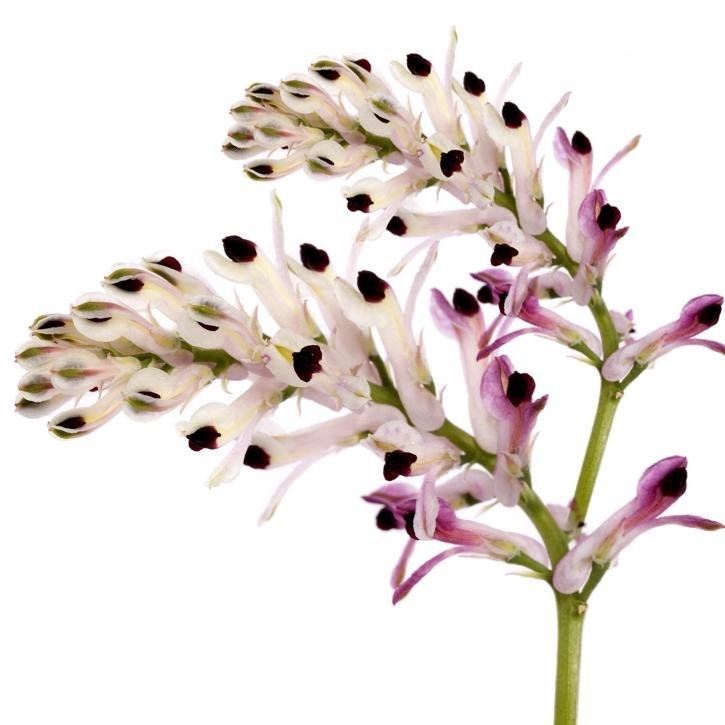Description
Herbaceous annual plant, up to 60 cm high with branched, erect and glabrous bluish-green stems. Leaves are alternate and petiolate, 2 to 3 times pinnately compound with their last divisions almost linear. Inflorescence in multiflower terminal racemes (apparently lateral). Small zygomorphic flowers, 7-9 mm long. Calyx is formed by two small whitish sepals, oval-shaped with toothed edges, narrower than the corolla. Corolla is formed by four free petals (connected to the apex but not fused), elongated. The upper one is extended with a wide protuberance where the nectary is. Androcium is formed by two stamens divided by three anthers. Central ones have two thecas, while the side ones have only one theca each (actually androceum is deadelphous: 6 staments fused in 2 groups). Bicarpelar gyneceum, with an upper ovary that fructificate in a small suborbicular achenium with truncated or marginated apex. It belongs to the Fumariaceae or Papaveraceae family.
It’s indigenous of Europe and Asia. It grows in nitrificated places and abandoned cultivations with fresh soil and roadsides. It blooms in early spring and the bloomed plant is harvested at the beginning of blooming (between April and June).
Part used
Flower apex.
Indications
Internal use
- Biliary dyskinesia, cholecystitis, cholelithiasis, cirrhosis, eases the symptoms related to liver disorders (weakness, lack of appetite, headaches, nausea, vomit).
- Hepato-biliary originated headaches.
- Bronchial asthma.
- Skin disorders: dermatosis, eczemas, psoriasis, skin exanthemas.
- Hyperlipidemias, arteriosclerosis prevention.
- Tachycardia and hypertension.
- Thromboembolisms and hyperglobulia prevention.
- Diarrhea.
External use
- Skin disorders: dermatitis, dandruff and seborrhea, psoriasis (fumaric acid).
- Conjunctivitis.
Bibliography
Fitoterapia Aplicada. J.B. Peris, G. Stübing, B.Vanaclocha. Colegio Oficial de Farmacéuticos de Valencia 1995.
Herbal Drugs and Phytopharmaceuticals. Norman Grainger Bisset (Ed). Max Wichtl. CRC Press.1994.
Plantas Medicinales y Drogas Vegetales para infusión y tisana. Edición española a cargo de: Salvador Cañogueral, Roser Vila, Max Wichtl.1998.
Matière Médicale. RR Paris- H. Moyse. Masson 1981.
Fitoterapia: Vademecum de Prescripción. Plantas Medicinales. B. Vanaclocha, S. Cañigueral. Editorial Masson. 4ª edición.
Plantas Medicinales. El Dioscórides Renovado. Pio Font Quer.
Guía de Campo de las Flores de Europa. Oleg Polunin. Ediciones Omega S.A. Barcelona, 1977.
Plantas Medicinales. Margarita Fernandez y Ana Nieto.Ed Universidad de Navarra. EUNSA 1982.
100 Plantes Medicinales. Max Rombi.Romart 1998.
Pharmacognosy, Phytochemistry, Medicinal Plants. Jean Bruneton. Lavoisier Publishing.
The Complete German Commission E Monographs. Therapeutic Guide To Herbal Medicines. Mark Blumenthal. American Botanical Council 1998.
Jean Bruneton. Farmacognosia. Fitoquímica Plantas Medicinales. 2ª Edición. 2001. Ed Acribia. S.A.
Bulletin officiel Nº 90/22 bis" del "Ministère des Affaires Sociales et de la Solidarité, Médicaments a base de Plantes.
Phytothèrapie. F. Hallard. Editorial Masson 1988.
Catálogo de Plantas Medicinales. Consejo General de Colegios Oficiales de Farmacéuticos. 2003.
